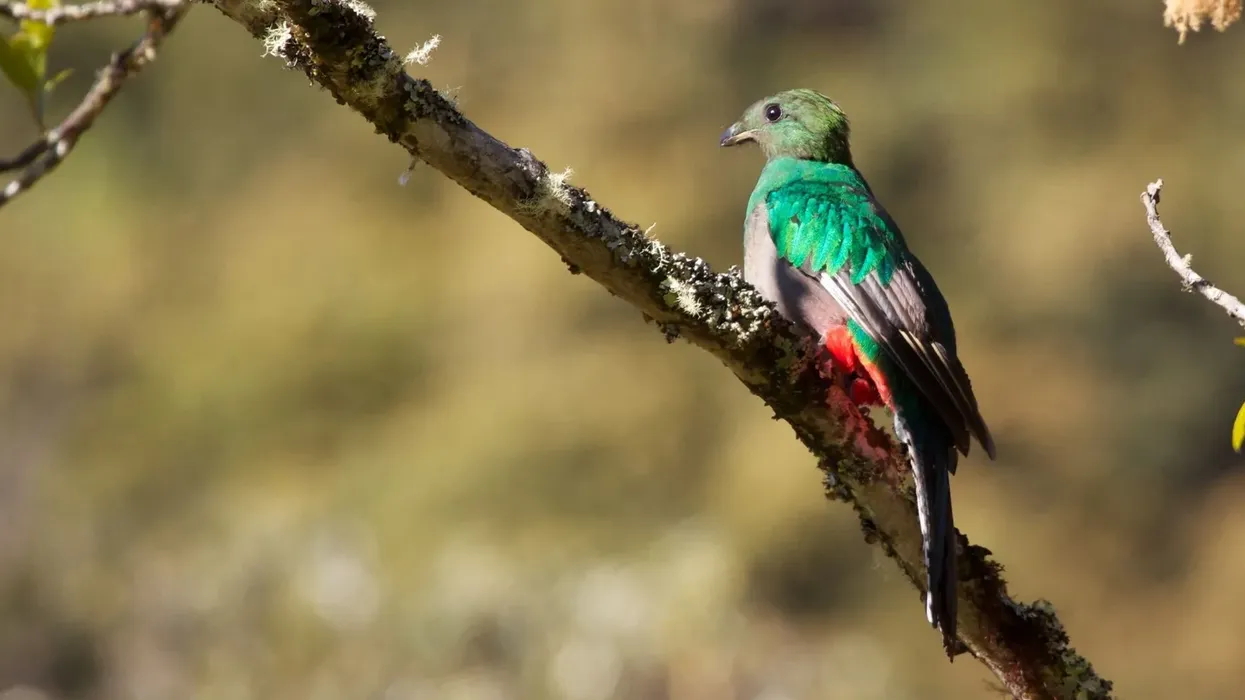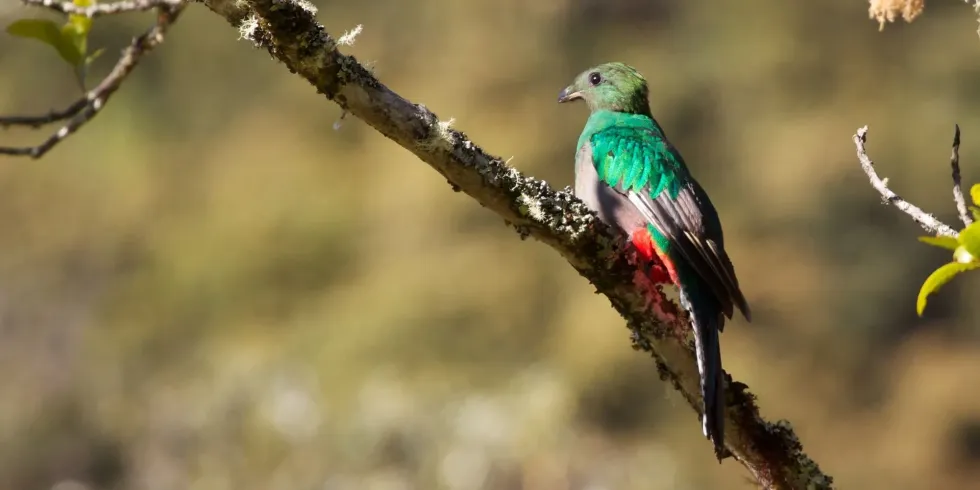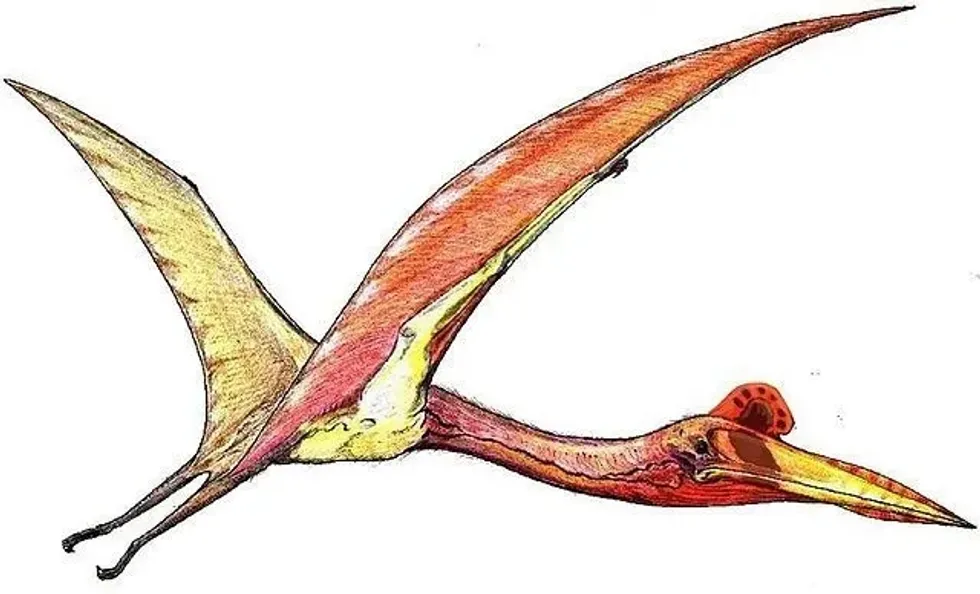The resplendent quetzal (pharomachrus mocinno) qualifies as the largest bird in the trogon family native to the Cloud Forest in Central America. Quetzals can be found from Chiapas, Mexico to western Panama.
There are two subspecies of resplendent quetzal namely Pharomachrus mocinno and Pharomachrus mocinno costaricensis. They are an important part of Mesoamerican mythology.
Pharomachrus mocinno is also the national bird of Guatemala. They are known for their colorful bodies. Most of which is green, but it is iridescent from green-gold to blue-violet with red on their breasts.
As the light hits their body, the quetzal's feathers can shine in various colors like green, yellow, or cobalt. Resplendent quetzals (pharomachrus mocinno) have green-colored tail plumes that cover and hide their tails.
Males have particularly fabulous tails, which are longer than their bodies along with a crest that is shaped like a helmet. They used to have very thin skin that could be easily torn, but the species has now evolved a thick plumage to protect it.
They are found in montane cloud forests from southern Mexico to western Panama. They are known to be weak fliers.
They can be found in vegetated ravines, open areas with scattered trees, and pastures in Mexico, Panama, Nicaragua, El Salvador, Guatemala, Honduras, and Costa Rica. They are known to be arboreal and altricial, as well as non-migratory.
Resplendent quetzal bird symbolism facts are even more interesting, which you'll get to know here. After reading these interesting resplendent quetzal facts, do check our other articles on the blue and yellow macaw and the great green macaw.
Resplendent Quetzal Interesting Facts
What type of animal is a Resplendent Quetzal?
Resplendent quetzals are a type of bird found in the Central and South American regions. They are known for their beautiful iridescent plumage.
What class of animal does a Resplendent Quetzal belong to?
The resplendent quetzal belongs to the class of birds or Aves of the animal kingdom. Like all birds, they are oviparous and lay eggs.
How many Resplendent Quetzals are there in the world?
The population of resplendent quetzals is ‘Near Threatened’ due to habitat loss and hunting for feathers and illegal trade. The numbers are said to be decreasing, which is a cause for concern.
Where does a Resplendent Quetzal live?
Resplendent quetzals are found in the cloud forest and montane forest of Central America. They range from Southern Mexico to Panama. They are found in the countries of Mexico, Panama, Nicaragua, El Salvador, Guatemala, Honduras, and Costa Rica.
What is a Resplendent Quetzal's habitat?
Resplendent quetzals are found in lush green vegetation or very moist rainforest zones, or cloud forests, and live in a nest hole. They are found in the cloud forest and montane forests of Central and South America.
They are high-altitude birds often found in high mountain ranges from 4000 to 10,000 ft. They live in the canopied trees of the rainforest. A female resplendent quetzal also prefers inhabiting decaying trees, stumps, and old woodpecker hollows.
They are loud birds that can camouflage themselves within their natural habitat of the rainforest. Quetzals are also found in the forests of Costa Rica and El Salvador.
Who do Resplendent Quetzals live with?
Resplendent quetzals are solitary birds and like to live alone. They gather in large numbers only on one tree during eating. They are found in pairs only during their mating seasons.
How long does a Resplendent Quetzal live?
Resplendent quetzals can live for up to 10 years. The species may not live for a longer duration due to illegal hunting for their feathers by trophy hunters. They are a near-threatened species of birds.
How do they reproduce?
The breeding season for resplendent quetzals is from March to June. The male resplendent quetzal will perform courtship dances along with calls and loud singing to attract the females.
They dig holes in a decaying tree’s bark but do not fill it up with nesting materials like thatch or leaves. They simply deposit their eggs on bare floors. Resplendent quetzals are called hole-brooders due to this behavior.
The male and female birds will dig these holes together. They nest 15-45 ft above ground and the holes are around 4.5in in diameter.
After this, they will mate inside these chambers. The female will lay two pale blue eggs on the floor of these chambers, and the eggs hatch after the incubation period.
Both the parents take turns, especially the female, incubating the eggs for 17-18 days. They have separate times to take care of the eggs during this period.
The females will brood during the midday and night, while the males will brood during late afternoons and early mornings. The hatchlings will be naked with closed eyes and white egg teeth near the tip of their upper mandible. Their eyes will remain closed for the first week, after which they will grow rapidly.
Resplendent quetzals have fully covered bodies with feathers, except their head. The feathers are soft and pale.
The hatchlings will look like their mothers during this period with muted tones of grey and dull greens. In the first week, the parents will feed them only insects.
The parents will keep their nest extremely clean by disposing of any debris or waste. As the young ones reach two weeks of age, the parents will start feeding them fruits, frogs, lizards, snails, and other vertebrates.
The young will remain in chambers under the care of their parents for three weeks. Then the male birds will teach them to fly by the third week. As they learn to fly more confidently, they will abandon their nests.
The young will continue to spend time with their parents after this transition too. The male quetzals do not develop their magnificent plumes until they are three years of age.
What is their conservation status?
The conservation status of resplendent quetzals is Near Threatened as per the IUCN Red List. However, in many countries, their habitats are being declared as protected areas as they are attractive species for birdwatchers and eco-tourists. The population of resplendent quetzals is nearly threatened due to habitat loss in cloud forests, hunting for feathers, and illegal trade.
Resplendent Quetzal Fun Facts
What do Resplendent Quetzals look like?

Resplendent quetzals, as the name suggests, are beautifully colored birds, with red breasts. They are known for their colorful bodies.
Most of which is green, but it is iridescent from green to gold or blue to violet with red on their breasts. As the light hits their body, the feathers can shine in a variety of colors such as cobalt, yellow, or ultramarine due to the presence of the melanin pigment.
They have green-colored tail coverts which hide their tails.
Males have particularly fabulous tails, which are longer than their bodies. The males also have a helmet-like crest.
The bill, covered by filamentous feathers, is yellow in males and black in females. They have a short strong beak. They have olive-gray-colored feet with four toes on each foot.
The resplendent quetzal female is more muted in tone than breeding males. Blue-green plumes cover their entire tail, which in some cases can be more than a meter long.
How cute are they?
The young quetzals are not just cute, but they are outright beautiful with their brilliantly colored plumage and long tails in the males.
How do they communicate?
They are noisy birds. They can be heard during cloudy dawns and misty afternoons. They are usually quiet during sunny or windy days. Their songs are treble syllables. They have six specific calls which are recorded.
How big is a Resplendent Quetzal?
The resplendent quetzal is the largest creature among the trogon family. They grow up to 15-26 in (38.1-66 cm) long with tail streamers which are a length of 12 in (30.5 cm). Some of the birds of this species have tails that are almost one meter long.
How fast can a Resplendent Quetzal fly?
Resplendent quetzals are weak fliers. These birds with colorful plumage are mostly sedentary birds that are found on the branches of trees.
How much does a Resplendent Quetzal weigh?
The resplendent quetzal weighs about 7.4 oz (209.8 g). These members of the trogon family are medium-sized birds with large tail streamers on the males.
What are the male and female names of the species?
The male and females of these species do not have a specific name. They are known as male resplendent quetzals and female resplendent quetzals. In terms of plumage, the males and females have a similar appearance but the females do not have the same red breast, long tails, and green crest as males.
What would you call a baby Resplendent Quetzal?
Baby resplendent quetzals do not have a specific name.
What do they eat?
The adult quetzals are fruit eaters. However, they do eat insects like ants, wasps, and larvae, and small creatures like frogs and lizards. They are fond of wild avocados and other fruits of the laurel family.
They will swallow the fruit whole and regurgitate the pit later. They feed during midday. They will use the method of hovering and stalling to select a fruit.
Are they dangerous?
Resplendent quetzals are not dangerous at all. They are an endangered species and need concentrated efforts to be protected.
Would they make a good pet?
They would make a very good pet provided you can give them the cloudy, misty high altitude, the lush green habitat they prefer. Due to their flimsy skin, they do not do well in captivity, however, they are hunted for their feathers and illegal trades.
Did you know...
The bird is known to kill itself in captivity, which is why it is used as a symbol of true liberty.
When is Resplendent Quetzal mating season?
The breeding season for resplendent quetzals is from March to June. The males will perform courtship dances along with calls and loud singing to attract the females.
They dig holes in a decaying tree’s bark but do not fill it up with nesting materials like thatch or leaves. They simply deposit their eggs on bare floors. They are called hole-brooders due to this behavior.
The male and female birds will dig these holes together. They nest 15-45 ft above ground and the holes are 4-4.5in in diameter. After this, they will mate inside these chambers.
The female will lay two pale blue eggs on the floor of these chambers. Both parents will take care of the eggs during the incubation period of 17-18 days.
Resplendent Quetzal Symbolism Facts
There are many symbolic facts associated with resplendent quetzals. Quetzals have a lot of significance in Mesoamerican mythology. Being the national bird of Guatemala, this species features on the flag and coat of arms of Guatemala. The currency of this country is also known as the Guatemalan quetzal.
Here at Kidadl, we have carefully created lots of interesting family-friendly animal facts for everyone to discover! Learn more about some other birds including the California quail and the quetzal.
You can even occupy yourself at home by drawing one of our resplendent quetzal coloring pages.










